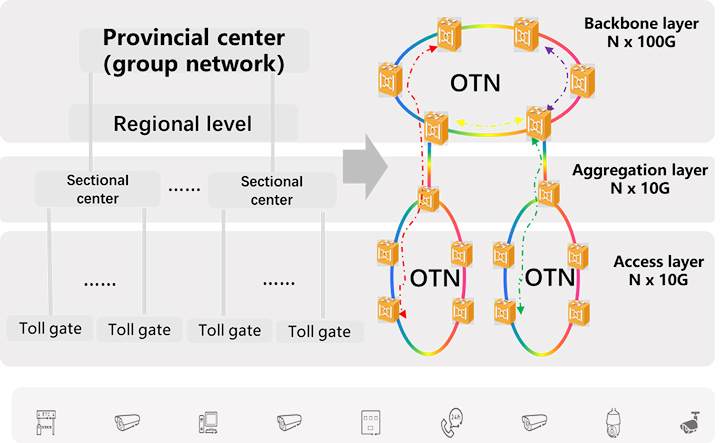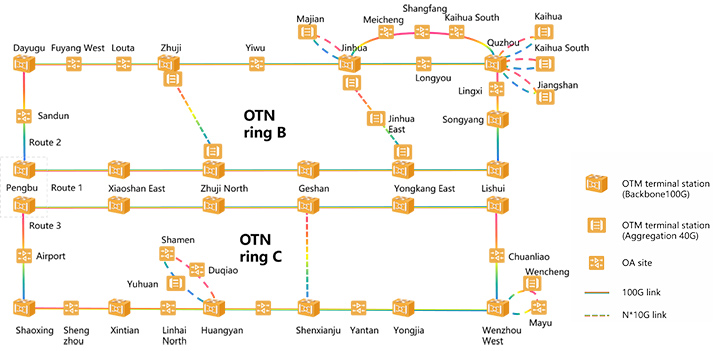By Applying F5G to Transportation, Huawei Contributes to Building Smart Expressway for Zhejiang Expressway Operation Company
Enterprise products, solutions & services
As a coastal province in southeast China, Zhejiang has been one of China's economic powerhouses since ancient times. The Grand Canal, which has a history of over a thousand years, starts in Zhejiang and since its construction has strengthened the economic exchange between the northern and southern parts of China, as well as promoting cultural exchange throughout the country. These days, expressways have become a key channel of economic and cultural exchange. Staying true to its roots, Zhejiang province has built expressways spanning more than 5000 km to form a mesh network, facilitating people's travel and greatly promoting economic development.
Today's expressways are becoming increasingly smart, and channel capabilities have been improved through the application of digital infrastructure. Following this trend, Zhejiang Communications Investment Expressway Operation Management Co., Ltd. (referred to as Zhejiang Expressway Operation Company) has teamed up with Huawei to apply the fifth-generation fixed network (F5G) to expressways, and built network connection infrastructure to boost expressway digitalization using an all-optical architecture, thereby providing strong support for expressway services.
As the expressway digitalization continues to ramp up, the gap between legacy basic communication network and current smart expressway construction widens gradually, with many issues exposed:
1. Communication networks have high security requirements and cannot reuse optical fiber resources. As such, networks are separately constructed in scenarios including tolling, video security, and office activities, consuming a vast number of fibers.
2. High-traffic services emerge, placing high demands on performance metrics such as transmission bandwidth. Bandwidth resources of legacy communication networks have reached the bottleneck.
3. Most legacy communication networks use single links, with network link interruption affecting expressway services.
4. Fiber cuts often occur on communication networks due to factors such as geological disasters, and the fiber cuts are difficult to locate. In this case, the maintenance efficiency and repair efficiency are quite low.
Using optical fibers as communication media, F5G has technological advantages including high security and reliability, ultra-high bandwidth, and easy O&M. After comparing a range of technical solutions, Zhejiang Expressway Operation Company eventually adopted F5G to construct an F5G all-optical communication network in a unified manner, building a multi-service integrated bearing platform spanning everything from sections to the group center.
Zhejiang expressways' F5G all-optical communication network uses a three-level architecture of "provincial backbone transmission network, sectional aggregation network, and communication access service network." This architecture matches the three-level architecture of Zhejiang expressway communication management: provincial center–sectional centers–toll gates.

• At the top of the transmission network, the backbone layer uses N x 100G networking, dispatches long-haul services between areas and the provincial center or between various areas according to the actual demand, and ensures their reliable transmission.
• Between the access layer and backbone layer, the aggregation layer uses N x 10G networking, aggregates all toll gate services within the area, and forwards the services to the upper level.
• Using N x 10G networking, the access layer aggregates and accesses end services including monitoring, tolling, and office for electromechanical equipment going in and out of toll gates, and then forwards the services to the upper levels.
The following figure shows the topology of Zhejiang Expressway Operation Company's F5G all-optical communication network.

In actual network deployment, both backbone rings B and C take Pengbu as the provincial management center, and service scheduling among areas is implemented by building area management centers including Wenzhou and Jinhua, as well as sectional centers including Yongjia and Geshan. For long-haul multiplex sections, OA devices are installed at toll gates along the way to provide optical signal optimization, thereby realizing "one-fiber access" of services covering toll gates, sectional centers, and the provincial center.
F5G all-optical communication network features the following:
• Unified bearing of multiple services: Leveraging 100% hard pipe isolation technology, the communication network based on native hard pipes (NHPs) implements strict physical isolation between all service systems to ensure that they do not affect each other. Using F5G all-optical communication network, Zhejiang Expressway Operation Company has realized integrated bearing of multiple services including tolling, video security, and office with one network, simplified the network structure, and reduced fiber consumption as well as network construction cost.
• Ultra-high bandwidth: Zhejiang Expressway Operation Company has used OTN to upgrade SDH, as well as increasing the bandwidth at the aggregation layer and access layer to N x 10G and at the backbone layer to N x 100G. Compared with the original system, the F5G all-optical communication network has increased bandwidth by more than 10 times and reduced latency by about 75%. Using F5G, Zhejiang Expressway Operation Company has achieved lag-free HD video transmission on all sections, as well as HD video networking. F5G all-optical communication network can support a maximum of 120 wavelengths per fiber and a maximum of 800G per wavelength. The network can meet the requirements of fast-growing services including smart expressway and vehicle-to-everything (V2X) for the next ten years.
• High reliability: When there are multiple routes on OTM nodes, the all-optical communication network connects all services that meet the requirements along sections such as Zhuji to Zhuji North and Jinhua to Quzhou, forming a "Partial mesh + OLP" protection structure. In doing so, service security and reliability are guaranteed to the greatest possible extent. For example, on the route spanning Jiangshan, Quzhou, and Pengbu, if there is a single-point device failure or a fiber cut on a link, switching can be completed within 50 ms through ring network protection, thereby ensuring the normal functioning of services such as tolling and video security. According to statistics, service interruptions caused by fiber faults have been reduced by 67%.
• Smart O&M: Fiber Doctor has also been applied in the all-optical communication network. Even when a fiber cut occurs — for example, due to geological disasters — the fiber cut position can be remotely located within minutes through the boards with OTDR detection functions, significantly improving on-site O&M efficiency.
Zhejiang Expressway Operation Company stays focused on the concepts of "security, efficiency, benefits, and harmony", and continues to improve the expressway service quality to ensure secure and smooth expressway operations. Looking ahead, the number of national expressways in Zhejiang province will increase from 18 to 22, and that of common national roadways from 15 to 19. The total planned mileage has exceeded 10,000 km.